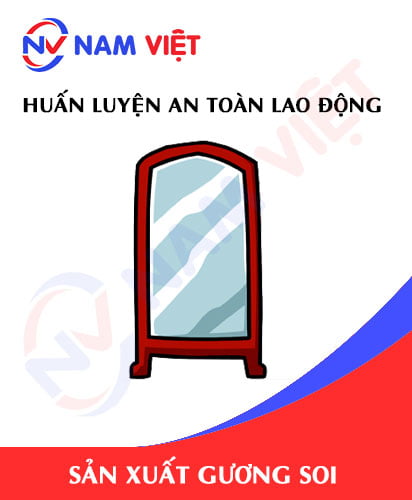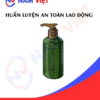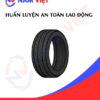Occupational Safety Training for Mirror Manufacturing
99,000 ₫
Note: The above price is calculated per person and may vary depending on the number of participants in the course and market fluctuations. For more accurate pricing support, please refer to the price list or contact our consulting staff directly.
Occupational safety is an important issue in mirror manufacturing factories and needs to be addressed promptly to ensure the health and safety of workers, as well as to enhance the reputation of businesses. The Occupational Safety Training course is one of the effective solutions to raise awareness of accident prevention for workers in mirror manufacturing.
Table of Contents
Toggle1. Overview of Mirrors
a. What is a mirror?
- A mirror is an item used to reflect the image of an object. Mirrors are usually made of flat or curved glass with a reflective surface coated with a layer of silver or alloy to create a clear reflected image. Mirrors are used for various purposes such as interior decoration, gyms, bathrooms, dressing rooms, or in industrial and scientific applications such as optical devices.
- According to statistics from the Ministry of Industry and Trade, Vietnam’s mirror export value in 2020 reached about 9.2 million USD. However, there are still many domestic manufacturing enterprises producing mirrors to meet the local market demand.
- The regions for mirror manufacturing in Vietnam are mainly concentrated in provinces and cities with a tradition of mirror manufacturing such as Hanoi, Hai Phong, Ho Chi Minh City, Binh Duong, Dong Nai, Bac Ninh, Thai Nguyen, Vinh Phuc…

b. Types of mirror manufacturing machinery
The types of machinery used in mirror manufacturing include:
- Glass cutting machines: Used to cut glass sheets to the desired size and shape.
- Coating machines: Used to apply silver layers and scratch-resistant coatings onto the glass surface.
- Glass bending machines: Used to bend glass sheets into various shapes.
- Mold-making machines: Used to create molds for producing different mirror shapes.
- Quality inspection machines: Used to check the quality of mirror products, ensuring they meet requirements for durability, flatness, and aesthetics.
These machines are applied in the mirror manufacturing process at large mirror factories.

c. Typical mirror manufacturing enterprises
In Vietnam, there are many mirror manufacturing enterprises, among which notable ones include:
- Hanoi Glass Company Limited
- Phu Tho Glass Manufacturing and Trading Company Limited
- Da Nang Glass and Mica Joint Stock Company (Dakico)
- Anh Tuan Glass and Accessories Company Limited
- Korean Glass Company Limited
- Thanh Dat Colored Glass Company Limited
- Phuong Nam Glass and Mirror Company Limited
- Vu Hoang Glass and Mirror Company Limited
- Hoa Binh Glass and Mirror Company Limited
- Nhat Thanh Mirror Company Limited
- My Thuat Vina Mirror Company Limited
- An Tam Glass and Mirror Company Limited
- Dong A Mirror Manufacturing and Trading Company Limited
These enterprises have experience and reputation in manufacturing and supplying high-quality mirrors, meeting domestic and international customer demand.
d. Specific jobs in a mirror manufacturing factory
Group 1
- CEO, Deputy CEO, department heads in a mirror manufacturing factory.
Group 2
- Safety officers: managing safety in the factory, designing safety procedures, supervising and ensuring staff comply with safe working processes.
Group 3
- Material preparation: includes flat glass sheets, chemicals, cleaning tools, and other necessary equipment.
- Glass cutting: using glass cutting machines to cut sheets to required sizes.
- Anti-reflective coating: applying chemicals to coat the glass surface with an anti-reflective layer.
- Scratch-resistant coating: after anti-reflective coating, apply a scratch-resistant layer to protect the mirror surface.
- Drying: glass sheets are placed in ovens to dry the coatings.
- Quality inspection: final products are inspected to ensure the mirrors meet requirements for gloss, flatness, smoothness, and accuracy.
- Packing and transportation: finished mirrors are packed and transported to required locations.
Group 4
- Office, service, sales, marketing work.
- Manufacturing management, quality management, human resources management, material management, financial and accounting management.
- Research and development of new products, packaging design.

2. Overview of occupational safety training for mirror manufacturing
This article focuses on Group 3 because Group 3 is directly involved in the manufacturing process and faces the highest occupational safety risks. Refer to other groups here.
a. What is Group 3 occupational safety training?
- Group 3 occupational safety training equips workers with knowledge on how to prevent workplace accidents.
- The training course helps workers recognize and avoid hazards, reducing the risk of occupational accidents during work.
REGISTER FOR OCCUPATIONAL SAFETY TRAINING SERVICE
b. Training duration
Initial occupational safety training
- Total training time is at least 24 hours, including assessment time.
- 8 hours of theory on occupational safety policies and regulations
- 8 hours of theory on basic occupational safety knowledge
- 4 hours of theory on specialized training content
- 2 hours of practical training on specialized content
- 2 hours of theory assessment at the end of the course
The safety training center will arrange the schedule into multiple sessions depending on workers’ availability. Typically, there are 6 sessions over 3 days if the manufacturing enterprise can arrange continuous training time.
Periodic occupational safety training
- Before the occupational safety card expires, workers who want re-issuance must undergo periodic occupational safety training, with a training duration of at least 50% of the initial training time.
Explanation: The total time for periodic occupational safety training is at least 12 hours, including assessment. After completing the periodic course and passing the test, workers will have their occupational safety card renewed.
c. Training content
| No. | TRAINING CONTENT | TRAINING DURATION (HOURS) | |||
| Total | Including | ||||
| Theory | Practice | Assessment | |||
| I | Occupational safety policies and regulations | 8 | 8 | 0 | 0 |
| 1 | Overview of legal documents and regulations on occupational safety. | 6 | 6 | ||
| 2 | System of standards and technical regulations for occupational safety. | 1 | 1 | ||
| 3 | Specific regulations from state authorities on occupational safety for construction, expansion, or renovation of facilities for manufacturing, using, storing, and inspecting machines, equipment, materials, or substances with strict safety requirements. | 1 | 1 | ||
| II | Basic occupational safety knowledge | 8 | 8 | 0 | 0 |
| 1 | Basic knowledge of hazards and harmful factors at the workplace. | 4 | 4 | ||
| 2 | Methods to improve working conditions. | 1 | 1 | ||
| 3 | Safety culture in manufacturing and business. | 1 | 1 | ||
| 4 | Rights and duties of employers and employees; occupational safety policies for employees; roles of safety officers. | 1 | 1 | ||
| 5 | Safety rules, signage, using safety devices and personal protective equipment; skills in first aid, occupational disease prevention. | 1 | 1 | ||
| III | Specialized training content | 6 | 4 | 2 | 0 |
| Comprehensive knowledge about machines, equipment, substances causing hazards; risk analysis, evaluation, and management; safe working processes with machines and substances requiring strict occupational safety standards. | 6 | 4 | 2 | ||
| IV | Final assessment of occupational safety training | 2 | 2 | 0 | 0 |
| Total | 24 | 22 | 2 | ||
See more training content of the 6 groups
d. Occupational safety card
After completing the occupational safety training and passing the test, workers will be issued a Group 3 occupational safety card (commonly called a Group 3 safety certificate).
The Group 3 card shows information such as full name, date of birth, job, and working environment. It also includes training duration, red seal, and signature confirming course completion.
According to the regulations in Clause 2, Article 24 of Decree 44/2016/ND-CP, there are two cases:
- If the employer and employee have a labor contract, the employer must stamp and endorse the safety card after the employee completes training from a safety training unit and passes the test.
- If the worker is freelance or seasonal with no labor contract, the training unit must stamp and endorse the safety card after the worker completes training from the occupational safety training unit and passes the test.

3. Identifying Hazards in Mirror Manufacturing
Potential hazards in mirror manufacturing may include:
- During mirror manufacturing, the use of chemicals and machinery requiring high electrical power can pose fire and explosion risks. To minimize these risks, factories need to be designed and equipped with effective fire and explosion prevention systems and strictly comply with safety regulations.
- Mirror manufacturing employees often work with large and heavy machinery and must move and install glass and mirrors. This can lead to collision, impact, or injury when handling sharp materials. Therefore, ensuring safety measures and training skills is crucial to prevent accidents.
- Some companies use radioactive materials in the production of special mirrors. Long-term exposure to these radioactive substances can pose health hazards, especially if proper protective equipment is not worn and safety regulations on radiation are not followed.
- Chemicals used in mirror manufacturing can cause serious health problems if not handled properly. These chemicals include acids, solvents, and dyes. Therefore, chemical usage must comply with safety regulations and ensure proper handling and storage procedures.
4. Common Occupational Accidents in Mirror Manufacturing
Common occupational accidents in mirror manufacturing include:
- Mechanical accidents: Employees using mirror cutting and polishing machines must be careful to avoid injuries from moving parts of the machines.
- Cuts and injuries: Employees may get cut or injured due to collisions or working in environments containing hazardous chemicals used in mirror manufacturing.
- Electric shocks: Employees may suffer electric shocks from using electrical equipment during manufacturing.
- Falls from height: Employees working at heights may fall and sustain serious injuries.
- Chemical toxicity risks: Chemicals such as ammonia, acids, lead, selenium, selenite, selenate, nickel, cobalt, arsenic, methane, propane, acetylene, oxygen, argon, nitrogen, helium, copper vapor, zinc vapor, and lead vapor used in mirror manufacturing may pose poisoning risks.
5. Safety Measures in Mirror Manufacturing
To ensure safety for employees in mirror manufacturing, the following safety measures should be applied:
- Employees must use protective equipment such as gloves, safety glasses, and masks to protect their eyes, hands, and respiratory system from chemicals, dust, and other hazards during manufacturing.
- Employees must receive full training on manufacturing processes, equipment maintenance procedures, and necessary safety measures during work.
- Factories need to use safety equipment such as safety sensors and automated machines to minimize accident risks during manufacturing.
- Mirror manufacturing equipment must be regularly inspected and maintained to ensure stable operation and reduce the risk of malfunctions.
- Factories must use safe materials and chemicals that do not harm employees or the environment.
- Factories must maintain a clean, ventilated working space and proper waste management systems to ensure employee health and environmental protection.
- Mirror products must undergo quality checks to ensure safety and compliance with technical standards and legal regulations.
- Periodically conduct workplace environment monitoring in factories, collect and analyze harmful factors for employees, and adjust to reduce hazards to prevent occupational diseases.

6. Benefits of Occupational Safety Training in Mirror Manufacturing
An Toan Nam Viet provides your business with the following benefits after completing occupational safety training courses in accordance with Decree 44/2016/ND – CP on occupational safety and hygiene:
- Employees can identify potential accident risks and take preventive measures to avoid accidents.
- Your business can establish risk prevention measures in manufacturing, operation, and maintenance processes.
- Minimize costs associated with safety incidents in labor.
- Uninterrupted production helps increase labor productivity and product quality.
- Comply with labor safety laws and avoid legal risks.
- Create credibility and professionalism in all aspects, enhancing your company’s brand value.
Nam Viet’s training courses are solutions to prevent external hazards, enabling individuals to avoid dangers that may lead to injury or even death.
REGISTER FOR OCCUPATIONAL SAFETY TRAINING
7. Customer Feedback after Completing Mirror Manufacturing Safety Training
An Toan Nam Viet has years of experience supporting many businesses in Vietnam in general and in southern provinces in particular. This responsibility is very precious to Nam Viet, which is why our Occupational Safety Training is increasingly professional. The motivation for our growth comes from positive feedback and suggestions from enterprises. Below are feedbacks from our partners.
Hoa Dat Construction and Trading Joint Stock Company
“Nam Viet’s service has greatly helped simplify occupational safety and complete safety documentation for our work process. The consulting team responded promptly to our questions. Five stars for Nam Viet.”
See more customer interview sessions after using the service of An Toan Nam Viet
8. Occupational Safety Training Capacity of An Toan Nam Viet
An Toan Nam Viet is a reputable and quality occupational safety training center in Vietnam. The occupational safety training sessions are continuously conducted at manufacturing workshops, factories, or construction sites nationwide (63 provinces in Vietnam).
REGISTER FOR OCCUPATIONAL SAFETY TRAINING
License for occupational safety training
- An Toan Nam Viet has been inspected and certified by the Department of Safety under the Ministry of Labor – Invalids and Social Affairs and granted a certificate confirming eligibility for occupational safety and hygiene training. This further strengthens our capacity in occupational safety training.

Materials and Lectures
- Before being used in occupational safety training courses, all training materials are reviewed and validated to ensure accurate knowledge and effective applicability.
- Teaching methods of instructors are standardized according to An Toan Nam Viet standards, developed by experts in occupational safety and hygiene training to maximize knowledge absorption for trainees.
Facilities
- Controlling classroom factors that affect training improves teaching efficiency and knowledge retention for trainees.
- Our training facilities are arranged with spacious classrooms meeting standards for area, lighting, and training equipment.
9. Nationwide Reputable Occupational Safety Training Center
At An Toan Nam Viet, we prioritize dedication to occupational safety training. For us, imparting knowledge for workers to protect themselves contributes to building the nation.
To ensure effective training, we meticulously prepare every detail, from tools, teaching equipment, curriculum, materials, to audio and lighting.
Our occupational safety instructors are experts with years of experience. They also have research on identifying hazards across various industries and methods to prevent them.
Instructors’ lectures are based on practical experience, delivered in an engaging, easily understandable way. This ensures workers are comfortable during training and absorb knowledge effectively. The content always aligns with Decree 44/2016/ND-CP.
Thus, workers learn hazard prevention measures and self-protection methods, applying them effectively in real work situations.
Our training center is proud to provide reputable and professional occupational safety training with the following advantages:
- Competitive training costs while maintaining training quality.
- Flexible training schedules to suit the company’s manufacturing operations.
- Quick and legal-compliant procedures for issuing occupational safety training certificates.
- Instructors with many years of professional experience.
- Classrooms controlled for factors affecting training efficiency and knowledge absorption.
- Lectures tailored to occupational safety practices in businesses.
- An Toan Nam Viet works dedicatedly and professionally to provide accurate and prompt support to clients.

10. Additional Reference Materials for Mirror Manufacturing Occupational Safety Training
- Mirror Manufacturing Occupational Safety Materials
- Occupational Safety Training Material Set
- Occupational Safety Test Set
- Mirror Manufacturing Occupational Safety Quiz
- Mirror Manufacturing Occupational Safety Training Slides
1 review for Occupational Safety Training for Mirror Manufacturing
No comments yet















namchinh.haiphong341
Bài giảng rất sinh động!